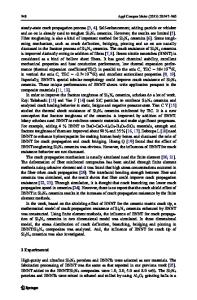Characterization and stabilization of Si 3 N 4 suspensions
- PDF / 522,423 Bytes
- 6 Pages / 576 x 792 pts Page_size
- 8 Downloads / 419 Views
S. Ardizzone Department of Physical Chemistry and Electrochemistry, University of Milan, Via Golgi 19, 20133 Milan, Italy
M. G. Cattania CSRSRC-CNR and Department of Physical Chemistry and Electrochemistry, University of Milan, Via Golgi 19, 20133 Milan, Italy (Received 1 March 1994; accepted 31 October 1994)
Two commercial Si3N4 powders were mixed with A12O3 and Y 2 O 3 through coprecipitation of the oxides from solutions of nitrates. The samples were characterized by XPS spectroscopy and electrophoretic mobility determinations on the suspensions. Sedimentation tests indicated that an oxylignin-based polyelectrolyte proved effective in the dispersion of the powders. The adsorption of the deflocculant followed Langmuir type isotherms characterized by values of the standard free energy of adsorption in the range typical of physisorption processes. The results of the different characterizations are discussed point by point, and different localizations of the dispersant in the interfacial region of the different samples are proposed.
I. INTRODUCTION It is generally recognized that the performance at high temperature of Si 3 N 4 can be improved through the control of the colloidal properties of the starting powders. This can be achieved provided that "specific" high performance mixtures of commercial raw materials (Si3N4 powders) and sintering aids are adopted on the basis of recent literature assessments.1"10 Fundamental investigations on hot-pressed materials have stressed the role of the purity and morphology of the raw material11; improved high temperature mechanical properties were obtained after the addition of sintering aids in the Si 3 N 4 matrix or after modification of the Si 3 N 4 particles colloidal behavior so as to improve its cold consolidation performance.12-13 Silicon nitride surface is partially oxidized, due to its thermodynamic instability in air, and consists of a layer with a composition corresponding to an intermediate state between silica and silicon oxynitride containing mainly silanol (Si-OH) and secondary amine groups (Si 2 -NH). 14 The composition of the surface films varies with manufacturing method and treatments, so that it results in different oxygen contents (1-2.5 wt. %) 15 and different relative amounts of amphoteric silanol and basic amine groups.16 Therefore, the colloidal behavior, which is strongly influenced by the surface composition, may vary widely so that the commercial powders show a pH iep value ranging from 3 to 9.15 Electrophoretic mobility measurements have also evidenced that, independently of the specific pH iep of the powder, the maximum value of mobility obtained is about 4 (/iitis" 1 J. Mater. Res., Vol. 10, No. 2, Feb 1995 http://journals.cambridge.org
Downloaded: 18 Mar 2015
V ! cm), too small to obtain an effective stabilization via an electrostatic mechanism. Further, the inhomogeneous nature of the surface (due to the contemporary presence of amphoteric and basic groups) makes it rather difficult to adsorb specific deflocculants.17 The Si3N4-based material
Data Loading...











